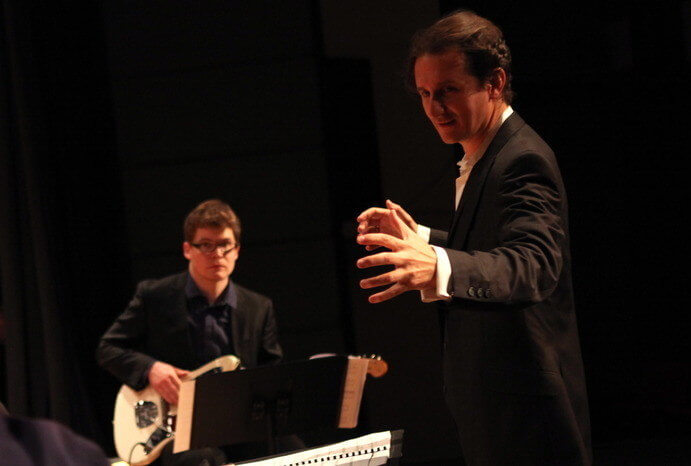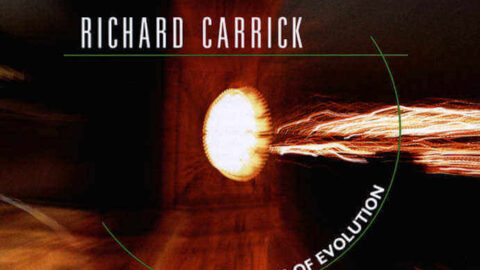Imagine a lava lamp. Shivering globules ooze around a tightly defined glass case in a state of amorphous flux. Your attention imperceptibly flows from one blobby shape to the next as they drift towards the top then sink down out of your notice. Occasionally a bubble subsumes another, or a larger one divides itself into two.
That’s what composer Richard Carrick’s new set of pieces Cycles of Evolution sounds like. A loosely connected group of five pieces written or revised in the last two years, Cycles of Evolution is the focus of a new recording of the same name released this year on New World Records.
In his extensive liner notes for the album, Brad Balliett suggests that one of the most prominent features of Carrick’s music is “the exploration of changes in relief and topography of sound.” Like in a lava lamp, the music is constantly fluctuating and morphing, different layers floating into the foreground while others shift out of relief to become a background, each layer defined by strict boundaries. And, as with a lava lamp, the music is mesmerizing for a while, but soon becomes familiar and uninteresting. Part of this is the lack of variety amongst the five pieces of Cycles of Evolution.

Namdaemun, conducted by Carrick and performed by musicians from the New York Philharmonic, establishes the pattern. Three strata of sound are present: sustained tones, shivering gestures centered around one pitch, and, eventually, slides upward and downward in the form of scales or glissandos. Each of these layers build and extend their scope, shouldering in front of each other until they start to shrink into an ending that recalls the opening. Subsequent pieces are structured similarly, and are even constructed of comparable materials; Carrick seems to enjoy pitting sustained pitches against tremolo-like figures. Different layers drift in and out of the foreground, seeping over one another and rising in a flood before receding.
The first four pieces gain any distinctness mostly from unusual instrumental colors. The Veins of Marble, performed by Carrick’s ensemble Either/Or and conducted by him (the same ensemble performs Dark Flow- Double Quartet), features a prominent cimbalom, its rattling and jangling eventually infecting the other instruments with shakes and quivers. Saxophone and acoustic guitar are added to the mix for Dark Flow–Double Quartet. Carrick’s writing for these two instruments is intriguing and masterful, the saxophone contributing rich howls and groans while the guitar intensifies the texture through frenetic strumming. The bass clarinet and electric guitar in Prisoner’s Cinema, recorded by Hotel Elefant under Carrick’s baton, are inspired touches. Roaring bass clarinet and flashes of distortion from the guitar inject the piece with an anxious energy.
The last piece of the cycle, Sub-merge, is the least like the rest. Its two movements, performed by Carrick at the piano and the DZ4 Wind Quartet, are supposed to depict a piano underwater. Such a vivid picture inspires music that does recall the murky movements and streams of bubbles underwater in the first movement, but the second movement is less obviously “submerged.” Nonetheless, it’s the standout track on the recording, with the piling up of an insistent rhythm in the winds driving the music forward while the piano picks out glittering harmonies.

The album is rounded out by the four Adagios for String Orchestra, performed by the String Orchestra of Brooklyn and the Toomai String Quintet with Carrick conducting. Like Cycles of Evolution, this group of pieces suffers from homogeneity, though it is distant from the sound-world of Cycles. Elegy (in memory of my father) sounds like a bitter attempt at a sumptuous Romantic Adagio, mournful strings growing in mournful harmonies and then cutting off at their loudest point, as if choked by sobs.
Suspended Adagio is like the Elegy, but more of a threnody or dirge. Solo has the clearest form of any piece on the album, focusing on a slightly grotesque, melancholy melody that is surprisingly tonal-sounding. Finally, Transcendent Coda ends with repeating, elegant fragments that cut off abruptly.
The shifting strata of Carrick’s music are lovingly sculpted by every ensemble on the recording, the tones rich and vibrant, the layers finely balanced. But while heaving topographies and drifting bubbles, even beautiful ones, are enticing for some time, they eventually lose interest. More linearity in contrast to Carrick’s usual state of flux as well as more variety amongst pieces would make for a less homogenous listen. I mean, when’s the last time you saw a lava lamp?
























